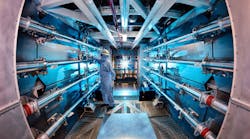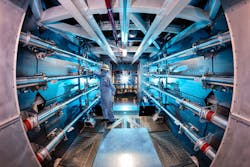Scientists at Lawrence Livermore National Laboratory’s Ignition Facility recently focused 192 ultrapowerful laser beams on a small deuterium-tritium-filled capsule in a target chamber. Nanoseconds later it imploded, releasing 8,000 J of neutron energy, three times the facility’s previous record of neutron yield for cryogenic implosions.
The experiment will help scientists refine computer models used to maintain the U. S. stockpile of nuclear weapons. It will also provide insight on fusion, a potential source of energy. Early calculations indicate that the fusion reactions in the hot plasma created by the implosion started to self-heat the core and enhanced the yield by 50%, pushing the reaction close to self-sustaining fusion. In fact, the implosion generated more energy than the lasers pumped into the capsule. And the lasers delivered 1.7 MJ of UV light at 350 terawatts of peak power.

